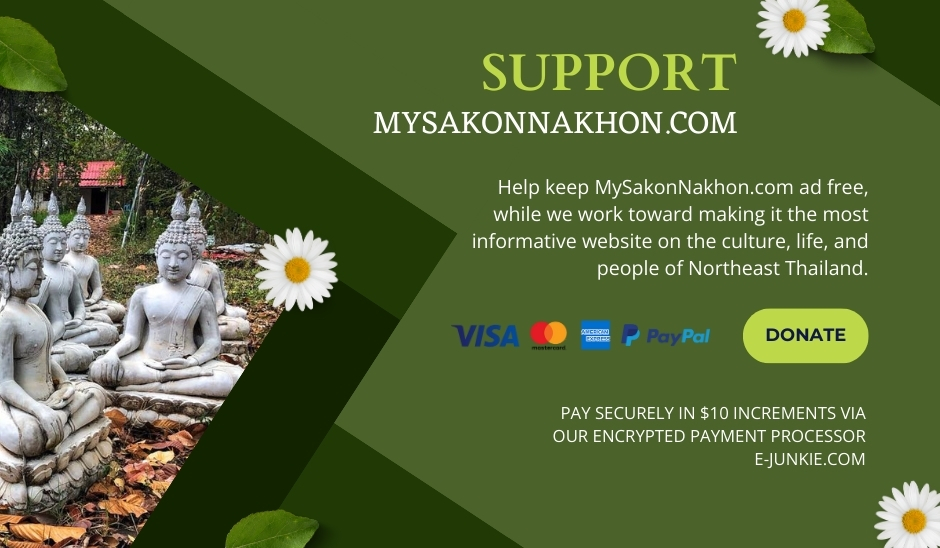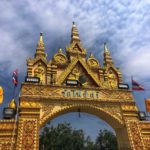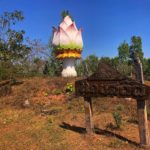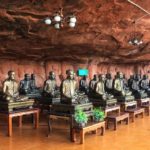
Naga Monument – Nakhon Phanom

The Naga Monument is a relatively new riverside attraction in the city of Nakhon Phanom. The immense brass Naga serpent statue was built in 2016 and cost 9 million baht (approx. $230,000). The elegant Buddhist sculpture has 7 heads, weighs 9 tons, and measures 4.49 meters wide and 10.90 meters high. The statue is facing North across the Mekong River which separates the city from the country of Laos on the other side. The Naga Monument is named Phaya Si Sattanakharat (พญาศรีสัตตนาคราช) and is believed to be the largest brass Naga sculpture in the Northeast of Thailand (Isaan).
The Naga serpent plays a prominent role in the mythologies and folklore of Thailand, as well as in the Buddhist religion — especially the 7-headed Naga known as Mucalinda. It is Mucalinda (King of the Serpents) who protected the Buddha from a terrible 7-day storm that arose immediately after his enlightenment. The Naga can take the form of a snake, serpent, or dragon, with anywhere from 1 to 9 heads, or it can take a half serpent, half human form (either male or female).
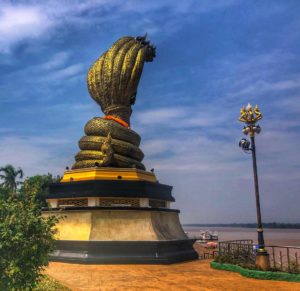
Legend has it that the Nagas are vigilant protectors of the Nakhon Phanom temple Wat Phra That Phanom, which houses the breastbone of the Buddha and is one of the most highly revered temples in Thailand. It’s also believed that an enormous Naga plowed with her chest the trenches that formed the Mekong River. Thus it is believed that the Naga live in the Mekong, and are responsible for the Naga fireballs that occur each year in the city of Nong Khai, which also is located on the Mekong River, about 4 hours west of Nakhon Phanom.
Nong Khai and Nakhon Phanom are therefore both considered Naga Cities, and if you travel two hours west of Nakhon Phanom, you’ll arrive in Sakon Nakhon, which also is considered a Naga City, where the Nagas are believed to live in Nong Han lake, the largest freshwater lake in the Northeast of Thailand. Gorgeous Naga statues can be found at hundreds of temples throughout Sakon Nakhon.
The Naga Monument in Nakhon Phanom has a hollow octagonal base, within which there is a small, glass encased Naga, and walls which tell the story (only in Thai language) of the creation of the Naga Monument. Please note that this is a sacred area, where Thai people make merit and seek the blessing of the Naga spirits, so be polite and wait your turn to enter the octagon if you want to take a picture inside. Below the monument, you’ll see a walkway which leads to an area where you can buy food, drinks, or souvenirs.
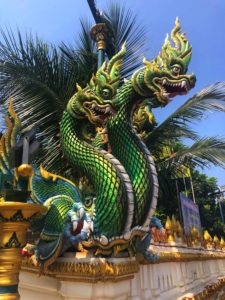
The Naga Monument is on the northern end of the promenade, which is opposite several beautiful temples. So, if you are making a visit to the monument, you should also take a walk south down the beautiful tree-lined pathway and visit the Nakhon Phanom temples on the riverfront. One sculpture you’ll see that you might find particularly unusual is a Naga serpent emerging from the mouth a vicious aquatic animal who appears to be eating it.
This sea creature is the semi-divine figure of Hindu mythology known as the Makara. The Makara is not eating the Naga, but rather the Naga is emerging from within the Makara, which symbolizes the birth of Buddhism from the Hindu legends that preceded it. Both the Makara and the Naga are guardian figures of temples in Thailand.
Visit the Nakhon Phanom Naga Monument
- How Men Vs. Women Speak Thai - May 13, 2024
- The Hidden Dharma of Thai Language & Culture - May 11, 2024
- The Royal Ploughing Ceremony in Thailand – A History - May 8, 2024
